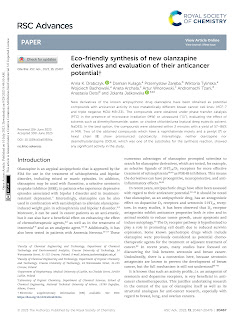Poniżej znajduje się lista moich publikacji naukowych (w trakcie aktualizacji).
2024 - 2023 - 2022 - 2021 - 2020 - 2019 - 2018 - 2017 - 2016 - 2015 - 2014 - 2013 - 2011 - 2010
2024
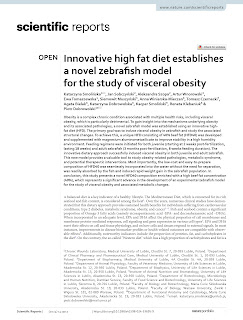 |
| DOI - PubMed - PPM nature.com ResearchGate |
Innovative high fat diet establishes a novel zebrafish model for the study of visceral obesity
Katarzyna Smolińska, Jan Sobczyński, Aleksandra Szopa, Artur Wnorowski, Ewa Tomaszewska, Siemowit Muszyński, Anna Winiarska-Mieczan, Tomasz Czernecki, Agata Bielak, Katarzyna Dobrowolska, Kacper Smoliński, Renata Klebaniuk, Piotr Dobrowolski
Sci Rep. 2024 Feb 6;14(1):3012
Abstract: Obesity is a complex chronic condition associated with multiple health risks, including visceral obesity, which is particularly detrimental. To gain insight into the mechanisms underlying obesity and its associated pathologies, a novel zebrafish model was established using an innovative high-fat diet (HFD). The primary goal was to induce visceral obesity in zebrafish and study the associated structural changes. To achieve this, a unique HFD consisting of 40% beef fat (HFD40) was developed and supplemented with magnesium aluminometasilicate to improve stability in a high humidity environment. Feeding regimens were initiated for both juvenile (starting at 2 weeks post-fertilization, lasting 18 weeks) and adult zebrafish (3 months post-fertilization, 8 weeks feeding duration). The innovative dietary approach successfully induced visceral obesity in both juvenile and adult zebrafish. This new model provides a valuable tool to study obesity-related pathologies, metabolic syndrome, and potential therapeutic interventions. Most importantly, the low-cost and easy-to-prepare composition of HFD40 was seamlessly incorporated into the water without the need for separation, was readily absorbed by the fish and induced rapid weight gain in the zebrafish population. In conclusion, this study presents a novel HFD40 composition enriched with a high beef fat concentration (40%), which represents a significant advance in the development of an experimental zebrafish model for the study of visceral obesity and associated metabolic changes.
2023
Anna K Drabczyk, Damian Kułaga, Przemysław Zaręba, Wiktoria Tylińska, Wojciech Bachowski, Aneta Archała, Artur Wnorowski, Andromachi Tzani, Anastasia Detsi, Jolanta Jaśkowska
RSC Adv. 2023 Jul 10;13(30):20467-20476
Abstract: New derivatives of the known antipsychotic drug olanzapine have been obtained as potential compounds with anticancer activity in two metabolically different breast cancer cell lines: MCF-7 and triple negative MDA-MB-231. The compounds were obtained under phase transfer catalysis (PTC) in the presence of microwave irradiation (MW) or ultrasound (“)))”), evaluating the effect of solvents such as dimethylformamide, water, or choline chloride/urea (natural deep eutectic solvent, NaDES). In the best option, the compounds were obtained within 2 minutes with a yield of 57–86% in MW. Two of the obtained compounds which have a naphthalimide moiety and a pentyl (7) or hexyl chain (8) show pronounced cytotoxicity. Interestingly, neither olanzapine nor desmethylolanzapine (DOLA), which was one of the substrates for the synthesis reaction, showed any significant activity in the study.
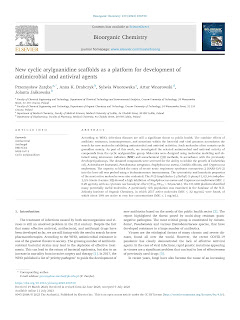 |
| DOI - PubMed ScienceDirect PPM - ResearchGate |
Przemysław Zaręba, Anna K Drabczyk, Sylwia Wnorowska, Artur Wnorowski, Jolanta Jaśkowska
Bioorg Chem. 2023 Oct;139:106730
Abstract: According to WHO, infectious diseases are still a significant threat to public health. The combine effects of antibiotic resistance, immunopressure, and mutations within the bacterial and viral genomes necessitates the search for new molecules exhibiting antimicrobial and antiviral activities. Such molecules often contain cyclic guanidine moiety. As part of this work, we investigated the selected antimicrobial and antiviral activity of compounds from the cyclic arylguanidine group. Molecules were designed using molecular modeling and obtained using microwave radiation (MW) and sonochemical ()))) methods, in accordance with the previously developed pathways. The obtained compounds were screened for the ability to inhibit the growth of Escherichia coli, Acinetobacter baumannii, Pseudomonas aeruginosa, Staphylococcus aureus, Candida albicans, and Cryptococcus neoformans. The capacity to block the entry of severe acute respiratory syndrome coronavirus 2 (SARS-CoV-2) into the host cell was probed using a bioluminescence immunoassay. The cytotoxicity and hemolytic properties of the most active molecules were also evaluated. The N-[2-(naphthalen-1-yl)ethyl]-5-phenyl-1,4,5,6-tetrahydro-1,3,5-triazin-2-amine 12j showed a high inhibition of Staphylococcus aureus and Cryptococcus neoformans (MIC ≤ 0.25 µg/mL), with no cytotoxic nor hemolytic effect (CC50, HC10 > 32 µm/mL). The CO-ADD platform identified many potentially useful molecules. A particularly rich population was examined in the database of the N.D. Zelinsky Institute of Organic Chemistry, in which 2517 active molecules (MIC ≤ 32 mg/mL) were found, of which about 10% are active at very low concentrations (MIC ≤ 1 mg/mL).
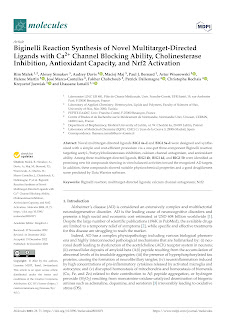 |
| DOI - PPM - MDPI ResearchGate Scopus |
Rim Malek, Alexey Simakov, Audrey Davis, Maciej Maj, Paul J Bernard, Artur Wnorowski, Helene Martin, José Marco-Contelles, Fakher Chabchoub, Patrick Dallemagne, Christophe Rochais, Krzysztof Jozwiak, Lhassane Ismaili.
Molecules. 2022 Dec 22;28(1):71
Abstract: Novel multitarget-directed ligands BIGI 4a-d and BIGI 5a-d were designed and synthesized with a simple and cost-efficient procedure via a one-pot three-component Biginelli reaction targeting acetyl-/butyrylcholinesterases inhibition, calcium channel antagonism, and antioxidant ability. Among these multitarget-directed ligands, BIGI 4b, BIGI 4d, and BIGI 5b were identified as promising new hit compounds showing in vitro balanced activities toward the recognized AD targets. In addition, these compounds showed suitable physicochemical properties and a good druglikeness score predicted by Data Warrior software.
 |
| DOI - PubMed - PPM MDPI |
Bartłomiej Barczyński, Karolina Frąszczak, Artur Wnorowski, Jan Kotarski
Cancers (Basel). 2023 Jan 10;15(2):451.
Abstract: Endometrial cancer is the most common female genital tract malignancy in developed countries that occurs predominantly in postmenopausal women. The primary objective of our research was to investigate whether menopause status together with selected conventional prognostic indicators may contribute to overall (all-cause) survival in endometrial cancer patients. For this purpose, we applied the Cox proportional hazards regression model. Patients in advanced FIGO stage showed a relatively poor survival rate. The time since last menstruation and postoperative FSH concentration were identified as unfavorable prognostic factors in our model. Additionally, age at diagnosis, BMI value, adjuvant treatment (brachytherapy), and parity showed no impact on survival. To our knowledge, this is the first study to report a prognostic model for endometrial cancer including exact time from last menstruation as one of the prognostic variables. Due to the fact that there are no stratifying systems to reliably predict survival in patients with endometrial cancer, there is a strong need to revise and update existing models using complementary prognostic indicators. Collection of precise data on various risk factors may contribute to increased accuracy of artificial intelligence algorithms in order to personalize cancer care in the near future.
2022
 |
| DOI - PubMed - PPM ResearchGate |
Artur Wnorowski, Danuta Dudzik, Michel Bernier, Jakub Wójcik, Guido Keijzers, Alberto Diaz-Ruiz, Karolina Mazur, Yongqing Zhang, Haiyong Han, Morten Scheibye-Knudsen, Krzysztof Jozwiak, Coral Barbas, Irving W Wainer
Sci Rep. 2022 Mar 7;12(1):3618
Abstract: Metabolic reprogramming contributes to oncogenesis, tumor growth, and treatment resistance in pancreatic ductal adenocarcinoma (PDAC). Here we report the effects of (R,S')-4'-methoxy-1-naphthylfenoterol (MNF), a GPR55 antagonist and biased β2-adrenergic receptor (β2-AR) agonist on cellular signaling implicated in proliferation and metabolism in PDAC cells. The relative contribution of GPR55 and β2-AR in (R,S')-MNF signaling was explored further in PANC-1 cells. Moreover, the effect of (R,S')-MNF on tumor growth was determined in a PANC-1 mouse xenograft model. PANC-1 cells treated with (R,S')-MNF showed marked attenuation in GPR55 signal transduction and function combined with increased β2-AR/Gαs/adenylyl cyclase/PKA signaling, both of which contributing to lower MEK/ERK, PI3K/AKT and YAP/TAZ signaling. (R,S')-MNF administration significantly reduced PANC-1 tumor growth and circulating L-lactate concentrations. Global metabolic profiling of (R,S')-MNF-treated tumor tissues revealed decreased glycolytic metabolism, with a shift towards normoxic processes, attenuated glutamate metabolism, and increased levels of ophthalmic acid and its precursor, 2-aminobutyric acid, indicative of elevated oxidative stress. Transcriptomics and immunoblot analyses indicated the downregulation of gene and protein expression of HIF-1α and c-Myc, key initiators of metabolic reprogramming in PDAC. (R,S')-MNF treatment decreased HIF-1α and c-Myc expression, attenuated glycolysis, shifted fatty acid metabolism towards β-oxidation, and suppressed de novo pyrimidine biosynthesis in PANC-1 tumors. The results indicate a potential benefit of combined GPR55 antagonism and biased β2-AR agonism in PDAC therapy associated with the deprogramming of altered cellular metabolism.
2021
 |
| DOI - PubMed ScienceDirect PPM - ResearchGate |
Katarzyna M.Targowska-Duda, Barbara Budzyńska, Agnieszka Michalak, Artur Wnorowski, Claus J. Loland, Maciej Maj, Dina Manetti, Maria Novella Romanelli, Krzysztof Jóźwiak, Grażyna Biała, Hugo R. Arias
Eur Neuropsychopharmacol. 2021 Nov;52:31-47
Abstract: The aim of this study is to determine whether type I and type II positive allosteric modulators (PAMs) of α7 nicotinic acetylcholine receptors (nAChRs) induce antidepressant-like activity in mice after acute, subchronic, and chronic treatments, and to assess whether α7-PAMs inhibit neurotransmitter transporters and activate mTOR (mammalian target of rapamycin) and/or ERK (extracellular signal-regulated protein kinases) signaling. The forced swim (FST) and tail suspension (TST) test results indicated that NS-1738 (type I PAM), PNU-120596 and PAM-2 (type II PAMs) induce antidepressant-like activity after subchronic treatment, whereas PAM-2 was also active after chronic treatment. Methyllycaconitine (α7-antagonist) inhibited the observed effects, highlighting the involvement of α7 nAChRs in this process. Drug interaction studies showed synergism between PAM-2 and bupropion (antidepressant), but not between PAM-2 and DMXBA (α7-agonist). The studied PAMs showed no high affinity (< 1 µM) for the human dopamine, serotonin, and noradrenaline transporters, suggesting that transporter inhibition is not the underlying mechanism for the observed activity. To assess whether mTOR and ERK signaling pathways are involved in the activity of α7-PAMs, the phosphorylation status of key signaling nodes was determined in prefrontal cortex and hippocampus from mice chronically treated with PAM-2. In conclusion, the antidepressant-like activity of type I and type II PAMs is mediated by a mechanism involving α7 potentiation but not α7 desensitization or neurotransmitter transporter blockade, and is correlated with activation of both mTOR and ERK signaling pathways. These results support the view that α7-PAMs might be clinically used to ameliorate depression disorders.
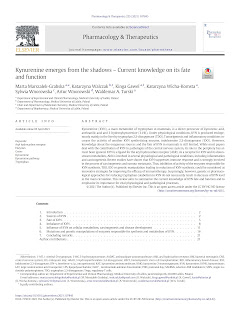 | |
| DOI - PubMed ScienceDirect PPM - ResearchGate |
Marta Marszałek-Grabska, Katarzyna Walczak, Kinga Gaweł, Katarzyna Wicha-Komsta, Sylwia Wnorowska, Artur Wnorowski, Waldemar A. Turski
Pharmacol Ther. 2021 Sep;225:107845
Abstract: Kynurenine (KYN), a main metabolite of tryptophan in mammals, is a direct precursor of kynurenic acid, anthranilic acid and 3-hydroxykynurenine (3-HK). Under physiological conditions, KYN is produced endogenously mainly in the liver by tryptophan 2,3-dioxygenase (TDO). Tumorigenesis and inflammatory conditions increase the activity of another KYN synthetizing enzyme, indoleamine 2,3-dioxygenase (IDO). However, knowledge about the exogenous sources and the fate of KYN in mammals is still limited. While most papers deal with the contribution of KYN to pathologies of the central nervous system, its role in the periphery has almost been ignored. KYN is a ligand for the aryl hydrocarbon receptor (AhR). As a receptor for KYN and its downstream metabolites, AhR is involved in several physiological and pathological conditions, including inflammation and carcinogenesis. Recent studies have shown that KYN suppresses immune response and is strongly involved in the process of carcinogenesis and tumour metastasis. Thus, inhibition of activity of the enzymes responsible for KYN synthesis, TDO, IDO or genetic manipulation leading to reduction of KYN synthesis, could be considered as innovative strategies for improving the efficacy of immunotherapy. Surprisingly, however, genetic or pharmacological approaches for reducing tryptophan catabolism to KYN do not necessarily result in decrease of KYN level in the main circulation. This review aims to summarize the current knowledge of KYN fate and function and to emphasize its importance for vital physiological and pathological processes.
Application of the SMALP technology to the isolation of GPCRs from low-yielding cell lines
Daniele Tedesco, Maciej Maj, Paulina Malarczyk, Andrea Cingolani, Mirko Zaffagnini, Artur Wnorowski, Jakub Czapiński, Tiziana Benelli, Rita Mazzoni, Manuela Bartolini, Krzysztof Jóźwiak
Biochim Biophys Acta Biomembr. 2021 Sep 1;1863(9):183641
Abstract: The ability of styrene-maleic acid (SMAc) co-polymers to spontaneously insert into biological membranes can be exploited to extract G protein-coupled receptors (GPCRs) embedded in styrene-maleic acid lipid particles (SMALPs), preserving the native environment around the protein and thus enhancing the feasibility of functional studies. So far, the SMALP technology has been primarily employed on non-mammalian cells and protocols are not optimized for adherent human cell lines, which cannot be harvested in large amounts. In this work, a fine investigation of key parameters affecting the formation of SMALPs was undertaken with the purpose of maximizing the yield of extraction of a recombinant form of human β2-adrenergic receptor (rhβ2AR) from HEK293T cells. The study highlighted an important influence of ionic strength on the membrane solubilization efficiency and GPCR purification yield of SMAc co-polymers: by lowering the salt concentration of all buffers used in previously published SMALP protocols, the water solubility and extraction efficiency of the selected SMAc co-polymer (commercially supplied as a potassium salt) were enhanced. In-line combination of size-exclusion chromatography (SEC) with immobilized metal affinity chromatography (IMAC) allowed further improvement of the final rhβ2AR yield by reducing the loss of SMALP-embedded GPCRs during the fractionation and purification of SMALPs. The overall findings of this study show that the available SMALP protocols can be significantly optimized in several aspects in order to increase the efficiency of GPCR solubilization and isolation from low-yielding expression systems.
2020
2018
2017
2016
2015
 |
| DOI - PubMed |
Artur Wnorowski, Mariola Sadowska, Rajib K Paul, Nagendra S Singh, Anna Boguszewska-Czubara, Lucita Jimenez, Kotb Abdelmohsen, Lawrence Toll, Krzysztof Jozwiak, Michel Bernier, Irving W Wainer
Cell Signal. 2015 May;27(5):997-1007
Abstract: (R,R')-4'-methoxy-1-naphthylfenoterol [(R,R')-MNF] is a highly-selective β2 adrenergic receptor (β2-AR) agonist. Incubation of a panel of human-derived melanoma cell lines with (R,R')-MNF resulted in a dose- and time-dependent inhibition of motility as assessed by in vitro wound healing and xCELLigence migration and invasion assays. Activity of (R,R')-MNF positively correlated with the β2-AR expression levels across tested cell lines. The anti-motility activity of (R,R')-MNF was inhibited by the β2-AR antagonist ICI-118,551 and the protein kinase A inhibitor H-89. The adenylyl cyclase activator forskolin and the phosphodiesterase 4 inhibitor Ro 20-1724 mimicked the ability of (R,R')-MNF to inhibit migration of melanoma cell lines in culture, highlighting the importance of cAMP for this phenomenon. (R,R')-MNF caused significant inhibition of cell growth in β2-AR-expressing cells as monitored by radiolabeled thymidine incorporation and xCELLigence system. The MEK/ERK cascade functions in cellular proliferation, and constitutive phosphorylation of MEK and ERK at their active sites was significantly reduced upon β2-AR activation with (R,R')-MNF. Protein synthesis was inhibited concomitantly both with increased eEF2 phosphorylation and lower expression of tumor cell regulators, EGF receptors, cyclin A and MMP-9. Taken together, these results identified β2-AR as a novel potential target for melanoma management, and (R,R')-MNF as an efficient trigger of anti-tumorigenic cAMP/PKA-dependent signaling in β2-AR-expressing lesions.
2014
-4%E2%80%B2-methoxy-1-naphthylfenoterol%20targets%20GPR55-mediated%20ligand%20internalization%20and%20impairs%20cancer%20cell%20motility.jpg) |
| DOI - PubMed |
Rajib K Paul, Artur Wnorowski, Isabel Gonzalez-Mariscal, Surendra K Nayak, Karolina Pajak, Ruin Moaddel, Fred E Indig, Michel Bernier, Irving W Wainer
Biochem Pharmacol. 2014 Feb 15;87(4):547-61
Abstract: (R,R')-4'-Methoxy-1-naphthylfenoterol (MNF) promotes growth inhibition and apoptosis of human HepG2 hepatocarcinoma cells via cannabinoid receptor (CBR) activation. The synthetic CB1R inverse agonist, AM251, has been shown to block the anti-mitogenic effect of MNF in these cells; however, AM251 is also an agonist of the recently deorphanized, lipid-sensing receptor, GPR55, whose upregulation contributes to carcinogenesis. Here, we investigated the role of MNF in GPR55 signaling in human HepG2 and PANC-1 cancer cell lines in culture by focusing first on internalization of the fluorescent ligand Tocrifluor 1117 (T1117). Initial results indicated that cell pretreatment with GPR55 agonists, including the atypical cannabinoid O-1602 and l-α-lysophosphatidylinositol, dose-dependently reduced the rate of cellular T1117 uptake, a process that was sensitive to MNF inhibition. GPR55 internalization and signaling mediated by O-1602 was blocked by MNF in GPR55-expressing HEK293 cells. Pretreatment of HepG2 and PANC-1 cells with MNF significantly abrogated the induction of ERK1/2 phosphorylation in response to AM251 and O-1602. Moreover, MNF exerted a coordinated negative regulation of AM251 and O-1602 inducible processes, including changes in cellular morphology and cell migration using scratch wound healing assay. This study shows for the first time that MNF impairs GPR55-mediated signaling and, therefore, may have therapeutic potential in the management of cancer.
2013
-4-methoxy-1-naphthylfenoterol%20in%20a%20rat%20C6%20glioma%20xenograft%20model%20in%20the%20mouse.jpg) |
| DOI - PubMed |
Michel Bernier, Rajib K Paul, Katina S S Dossou, Artur Wnorowski, Anuradha Ramamoorthy, Arnaud Paris, Ruin Moaddel, Jean-François Cloix, Irving W Wainer
Pharmacology Research & Perspectives. 2013 Dec;1(2):e00010
Abstract: (R,R')-4-methoxy-1-naphthylfenoterol (MNF) inhibits cancer cell proliferation in vitro through cell-type specific modulation of β2-adrenergic receptor and/or cannabinoid receptor function. Here, we report an investigation into antitumor activity of MNF in rat C6 glioma cells. The potent antiproliferative action of MNF in these cells (IC50 of ∼1 nmol/L) was refractory to pharmacological inhibition of β2-adrenergic receptor while a synthetic inverse agonist of cannabinoid receptor 1 significantly blocked MNF activity. The antitumor activity of MNF was then assessed in a C6 glioblastoma xenograft model in mice. Three days after subcutaneous implantation of C6 cells into the lower flank of nude mice, these animals were subjected to i.p. injections of saline or MNF (2 mg/kg) for 19 days and tumor volumes were measured over the course of the experiment. Gene expression analysis, quantitative RT-PCR and immunoblot assays were performed on the tumors after treatment. Significant reduction in mean tumor volumes was observed in mice receiving MNF when compared with the saline-treated group. We identified clusters in expression of genes involved in cellular proliferation, as well as molecular markers for glioblastoma that were significantly downregulated in tumors of MNF-treated mice as compared to saline-injected controls. The efficacy of MNF against C6 glioma cell proliferation in vivo and in vitro was accompanied by marked reduction in the expression of cell cycle regulator proteins. This study is the first demonstration of MNF-dependent chemoprevention of a glioblastoma xenograft model and may offer a potential mechanism for its anticancer action in vivo.
2011
 |
| DOI - PubMed |
Monika Oldak, Liv Tolzmann, Artur Wnorowski, Marta Justyna Podgórska, Steffi Silling, Rongtuan Lin, John Hiscott, Cornelia Sigrid Lissi Müller, Thomas Vogt, Hans Smola, Sigrun Smola
Journal of Virology. 2011 Jan;85(1):178-88
Abstract: The genus β human papillomavirus (HPV) type 8 is associated with nonmelanoma skin cancer in patients with epidermodysplasia verruciformis, and evidence for its protumorigenic potential in the general population increases. To date, strategies to suppress genus β HPV infections are limited. Interferon regulatory factors IRF-3 and IRF-7 play key roles in the activation of the innate immune response to viral infections. In this study, we show for the first time that both IRF-3 and IRF-7 regulate transcription of a papillomavirus, but with opposing effects. IRF-7, expressed in the suprabasal layers of human epidermis, increased HPV8 late promoter activity via direct binding to viral DNA. UV-B light-induced activation of the HPV8 promoter involved IRF-7 as a downstream effector. In contrast, IRF-3, expressed in all layers of human epidermis, induced strong HPV8 suppression in primary keratinocytes. IRF-3-mediated suppression prevailed over IRF-7-induced HPV8 transcription. Unlike the E6 oncoprotein of the mucosal high-risk HPV16, the HPV8 E6 protein did not bind to IRF-3 and only weakly antagonized its activity. Strong antiviral activity was also observed, when keratinocytes were treated with potent IRF-3 activators, poly(I:C) or RNA bearing 5' phosphates. In conclusion, we show that IRF-3 activation induces a state of cell-autonomous immunity against HPV in primary human keratinocytes. Our study suggests that local application of IRF-3-activating compounds might constitute an attractive novel therapeutic strategy against HPV8-associated diseases, particularly in epidermodysplasia verruciformis patients.
2010
 |
| DOI - PubMed |
Monika Ołdak, Cezary Kowalewski, Radosław B Maksym, Katarzyna Woźniak, Agnieszka Pollak, Marta Podgórska, Artur Wnorowski, Joanna Kosińska, Rafał Płoski
J Dermatol Sci. 2010 Jan;57(1):69-70
